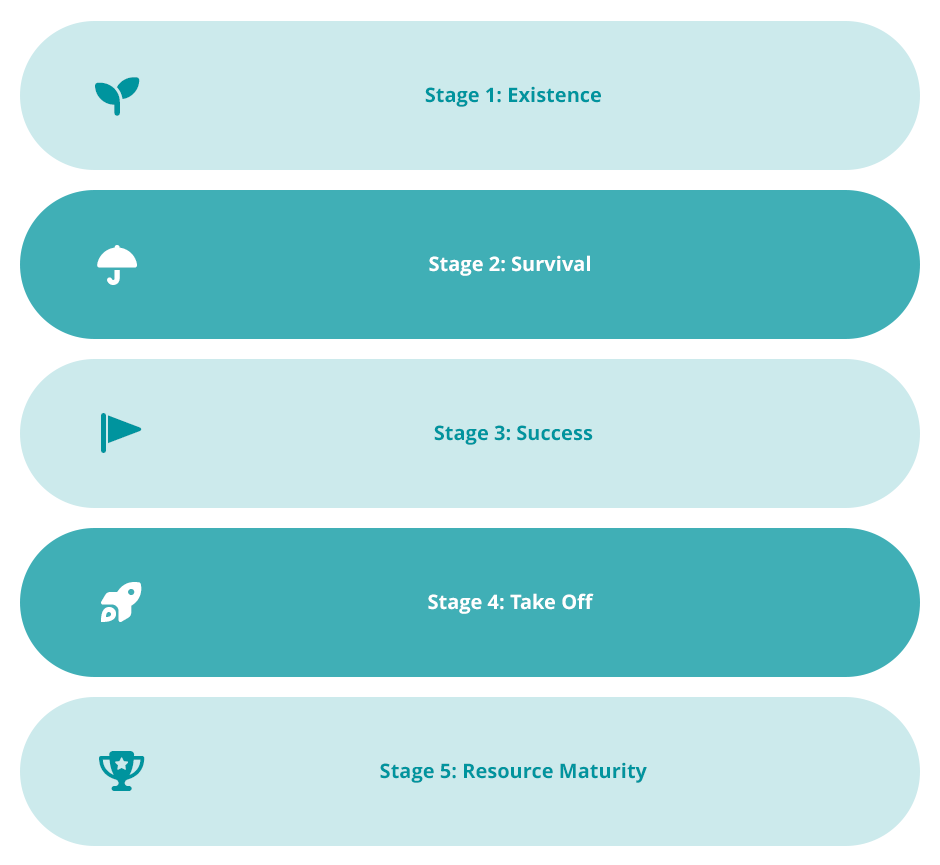Business growth isn’t a haphazard process of business development – there are distinct stages to business growth. In fact, we can divide up, monitor, and define the five stages of business growth which ensure long term prosperity.
Do you want to grow your business but you’re not sure how to create a business growth process? By having these phases of growth laid out, you can be sure of which phase of the journey you’re on and what comes next.
It’s a handy way to keep your business on track and be sure you’re progressing through the stages of business growth and toward increased stability and profitability.
Growth process: the Five stages of small businesses growth
Let’s outline and examine the five stages of small business growth.

Stage 1: Existence
In the Existence stage of business growth, you’re consumed with ‘staying alive’ after bringing your business idea to life. In this initial phase you’re focused upon:
- obtaining customers
- delivering your products and/or services
Throughout the Existence phase, you’ll be operating a top-down model. You as the business owner will be calling the shots and directing employees toward sales, product, marketing, and customer goals.
You might have no employees and everything comes down to you.
Your systems will be minimal to non-existent. Just like a startup, you’ll be focused purely on expanding your customer base, selling your products, and earning enough money to keep afloat.
Things you’ll be questioning during the Existence stage:
- How do we acquire customers?
- Can we deliver our products or services adequately enough to remain viable?
- Can we expand our customer base?
- Do we have enough resources and capital to continue operating?
Stage 2: Survival
Once you’ve endured the Existence stage, it’s on to the Survival stage.
In the Survival stage, you’re still fresh but you’ve now demonstrated that there’s a need for your offerings. There’s proof in the pudding and you’ve carved out some market share.
Now you know the business model is viable, you’ll be focused on:
- the relation between revenue and expenses
- making your business solidly profitable
- a return on investment for your capital assets and equipment
- maintaining adequate finances and the servicing of debt.
Basically, can you earn a profit by covering your expenses and investments with revenue and regular cashflow?
The business model is still simple, and the decisions are being made by the owner(s), with reporting from employees (if you have any).
Systems are still at a minimum and, if they exist, are centred squarely on cashflow forecasting.
Many businesses will remain in the Survival stage for some time, geared toward basic profitability and striking a manageable balance of expenditure vs revenue, without sliding into arrears.
Stage 3: Success
When you reach the Success stage, you’re now running a profitable and stable business which is cash positive and has a robust long-term outlook.
You’ll have two primary choices in the Success stage of business growth:
- You can choose to step back from day to day operations, appoint managers and retreat from direct involvement by letting the business maintain its status quo.
You’ll not be pursuing aggressive growth strategies, but rather choose to earn more passive income from a stable and healthy business. - The other course of action is aggressive growth. In the Success stage you can also choose to put more chips on the table, leverage financing, capital or investment and pursue a higher risk/higher return avenue.
You may choose to pursue new markets, new products, create partnerships, invest in employees or any other manner of expansion.
Which fork you choose to grow a business will depend on your particular aims – passive income vs potential for greater reward (with all the risks associated).
Stage 4: Take Off
The Take Off stage of business growth is when you’ve chosen to pursue the second avenue in the Success stage: aggressive expansion. This is the stage of development to make a business much bigger than it already is with rapid growth.
The opportunity in this stage of business growth is to make it big and sit at the helm of a large and valuable company.
You’ll be focused on:
- generating enough cash and financing to buttress your growth and increased expenditure
- making strategic decisions on where to focus your growth efforts
- employing competent managers and key staff
- decentralising the business.
Many businesses can fail in this stage of business growth by either running out of cash through over expansion or through poor (or unfortunate) strategic management. Poor staff and manager performance can also be an issue at this stage.
Alternatively, in the Take Off stage of business growth you may also be looking to sell the company, as it will now hold value in the eyes of external parties.
Stage 5: Resource Maturity
You’ve mastered the four stages of business growth before this and now you’ve arrived at the Holy Grail of all business owners – Resource Maturity. This maturity phase is the coveted stage of business growth where everything falls into place.
The Resource Maturity stage will involve:
- balancing and consolidating the rewards of successful expansion with operational costs
- full decentralisation and separation of owner and business
- fully developed systems and strategic capability
- maintaining entrepreneurial spirit and agility without sacrificing stability and cashflow
- careful expansion of the workforce
- being fully resourced with the ability to withstand market ebbs.
At this final stage of business growth, the owners often choose to step back, almost completely, and enjoy the dividends of their creation, or sell the company for a large profit.
Challenges in the growth stage of a business
It’s no secret that many businesses will never reach the final stage of business growth. A combination of an excellent idea with intelligent decision making, balancing risk vs reward, and positive cash flow is required.
Many businesses will stay at earlier growth stages of the business life cycle and remain healthy and profitable without the need to progress through every stage of business growth.
Not every successful business has to make the same aggressive or passive decisions for growth. What’s most important is making the decisions that are right for you and your business.























